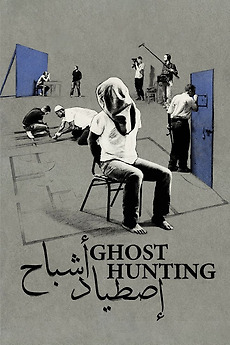Israel’s Moskobiyeh interrogation center in Jerusalem leaves long-lasting effects on those who were held captive. Palestinian director Raed Andoni sent a casting call for former prisoners to reenact their detainment experiences for his docudrama Ghost Hunting. Andoni aimed to build a replica of their cells and the interrogation rooms from firsthand experience; he explains that it not only gives authenticity but that building the replica serves the purpose of letting cast members express themselves creatively just as during the dramatic scenes.
Participants auditioned for their roles as guards and inmates. They were tasked with portraying the physical and psychological torture they endured during their time in the detention centers, which included sleep deprivation, solitary confinement, and sexual abuse. Throughout the film, role-playing elements that dramatize the participant’s real-life experiences are added, creating a loose narrative that allows the viewer to understand the hostile environment inmates experience at interrogation centers.
The film begins with an animated sequence of a figure whose head is covered and tied to a chair. It is revealed that this figure represents Andoni when he was incarcerated in Moskobiyeh at 18 years old. His experience appears in visions, along with other fleeting episodes of dreamlike animation based on Andoni’s hallucinatory flashbacks he had as a young detainee.
The piece develops into a deconstructed documentary that does not focus on a singular story, but becomes a vehicle for the film’s participants to open up about their emotional scars and reconcile the past; a project that can be seen as a group therapy session for its participants, with the crew recording them through the auditions, rehearsals, set construction, and shooting process.
The story of Ghost Hunting is loosely based on the experiences of Mohammed “Abu Atta” Khattab, who serves in a supervisory role and is portrayed by Ramzi Maqdisi. Abu Atta is shown instructing Ramzi throughout the scenes as he relives his past, demonstrating the interrogation and torture techniques that were used on him during his time at Moskobiyeh. The demonstrations prove to be too much to bear for Abu Atta as shown when he is rehearsing a scene with Ramzi and he aggressively slams Ramzi against a wall reflecting the violent assaults that he experienced from his interrogators, which leaves both men shaken. Such emotional outbursts are shown alongside candid confessions that bring back the dark memories that torment the film’s participants on a daily basis.
Abu Atta confessed how he and other inmates defied their interrogators in small actions of resistance against their confinement and persecution. An example was when the Israeli interrogators refused to let prisoners go to the toilet in an attempt to use their bodies against them and urinate on themselves. Abu Atta explained that after these acts of humiliation, if the prisoner acted and stood strong instead of feeling shame, he felt a sense of strength and resilience that these acts of disobedience bring. Inmates like Abu Atta who remain firm under pressure are often celebrated as folk heroes among Palestinians, and the songs inmates sing in resistance help keep their spirits intact. Palestinian prisoners use art, literature, humor, and music to escape inside themselves during confinement.
As shown in the following scenes, what becomes problematic for survivors of interrogation centers is the emotional trauma that torments them which can take a lifetime to heal. These repressed memories come out as the cast members and crew give detailed descriptions of Moskobiya’s cells and layout. Before Abu Atta’s outburst, as the crew goes over the prison’s blueprint one former inmate of Moskobiyeh confesses his brother who was detained in the cell for inmates with psychological problems attempted to commit suicide as a result of the torture and humiliation he endured. The former inmate expresses his guilt for not being there for his brother which has haunted him for years. He later on says that through the making of the film, he was able to express his trauma and finally feel happiness for the first time since his time at the detention center. This sentiment can be seen in the rest of the film’s cast in one-on-one conversations with the director and the on-set psychologist, sharing stories among themselves, and coming together to heal in camaraderie and companionship. The last scene shows the director opening the warehouse door of the set and leaving followed by the animated ghost of his past that haunts him as he continues to move forward.
Ghost Hunting is a powerful and haunting documentary that delves into the psychological scars left by interrogation and detention. Through reenactments and personal testimonies, the film sheds light on the trauma experienced by Palestinian detainees and the struggle to cope with those memories, highlighting the long road to healing, making it both an emotional and thought-provoking experience for viewers. It not only documents the horrors of confinement but also serves as a therapeutic process for the participants, allowing them to confront and express their pain.
Ghost Hunting received the first prize for documentary at the Berlin International Film Festival in 2017 and was nominated for best documentary at the Philadelphia Film Festival and the Seattle International Film Festival.
The film ends with a message dedicating the project to 1) Abdullah Moubarak, a member of the cast who was back in jail when the film finished, and also to 2) the 750,000 Palestinians, including children, who have experienced Israeli prisons and interrogation centers since 1967.
Discussion Questions:
- What do the dreamlike animated sequences convey? What do you think they represent?
- What does the film offer in its examination of how men cope with traumatic events and PTSD?
- Do you think the film overall was a beneficial experience for those involved? Or do you believe revisiting traumatic events brings more harm than good?
- How does the film convey to the audience the lasting effects of the mass incarceration of Palestinian people?


